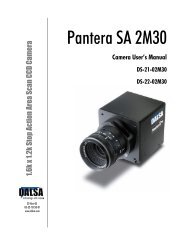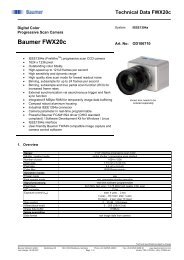Create successful ePaper yourself
Turn your PDF publications into a flip-book with our unique Google optimized e-Paper software.
DS-24-0<strong>2M30</strong> and DS-25-0<strong>2M30</strong> <strong>User</strong>’s <strong>Manual</strong> 65<br />
Step One: Preparing the Camera for<br />
LUT Calibration<br />
In this step, you will be configuring your camera settings to begin the LUT<br />
calibration procedure. You will first calibrate your camera to your desired operation<br />
conditions and then calibrate the camera in preparation for LUT calibration.<br />
Note: This flowchart assumes you are familiar with using the <strong>2M30</strong> command set.<br />
For a detailed explanation of any of the camera commands used in the following<br />
procedure, refer to Chapter 3 and Appendix B.<br />
Begin Step One<br />
Thermally stabilize camera.<br />
See Camera Thermal<br />
Equilbrium for details.<br />
Set normal operating<br />
conditions.<br />
See Normal Operating<br />
Conditions for details.<br />
Set LUT calibration<br />
operating condition.<br />
See LUT Calibration<br />
Operating Conditionsfor<br />
details.<br />
Proceed to Step Two<br />
Allow camera to reach thermal equilibrium. The camera should be<br />
thermally stable within 45 minutes of operation.<br />
Follow these steps to set camera to your desired operating conditions:<br />
1. Apply your system illumination.<br />
2. Disable factory LUT using the command, flm . 0<br />
3. Disable output LUT using the command, eol . 0<br />
4. Set exposure mode using the command sem . i<br />
5. Set frame rate (if applicable to exposure mode) using the command ssf . i<br />
6. Set exposure time (depending on exposure mode) using the command<br />
set i.<br />
7. Set background subtract value to 0DN using the command ssb 0 . 0<br />
8. Set digital gain to 1.0x using the comm and ssg 0 1.0.<br />
9. Set binning mode using the command sbm i . i<br />
101. Set any necessary pretrigger using the command sp . i<br />
11. Set analog offset using the command sao t . iUnder dark conditions,<br />
ensure that the analog offset is matched for both taps within ±1DN.<br />
Otherwise, match as best as possible. For best results, there should be no<br />
zeros present in the output data. To test for zeros, apply a histogram to the<br />
grabbed image.<br />
12. Set analog gain using the command sg t i. Under illuminated conditions,<br />
ensure that the analog gain is matched with both taps within ±10DN.<br />
Otherwise, match as best as possible.<br />
13. Repeat steps 11 and 12 as necessary.<br />
Follow these steps to configure the camera in preparation for LUT calibration:<br />
1. Apply uniformly white imaging target or defocused columated illumination to<br />
front of camera.<br />
2. Set camera to exposure mode 2 using the command sem . 2<br />
3. Set frame rate to 30 fps using the command ssf 30 .<br />
4. Set exposure time to 32000 µsec using the command set 32000.<br />
5. Leave camera background subtract set to 0 DN using the command ssb 0 . 0<br />
6. Leave camera analog offset unchanged at your normal operating mode setting.<br />
7. Leave d igital gain set to 1.0x ( ssg 0 1.0) .<br />
8. Leave the camera analog gain setting unchanged at your normal operating<br />
mode setting.<br />
9. Set the video output mode to normal using the command svm . 0<br />
10. Set the data output mode to 10 bits using the command sdm . 0<br />
11. Set binning mode to 1x1 using the command sbm 1 . 1<br />
12 Leave input LUT disabled ( eil 0).<br />
13. Leave output LUT disabled ( eol 0).<br />
DALSA 03-32-10157-02
















